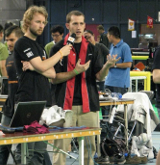Towards Autonomous Sensor and Actuator Model Induction on a Mobile Robot
Towards Autonomous Sensor and Actuator Model Induction on a Mobile Robot.
Daniel
Stronger and Peter Stone.
Connection Science, 18(2):97–119,
2006. Special Issue on Developmental Robotics.
Connection
Science Journal. Contains material that was previously published in an ICRA-2005
paper.
Download
[PDF]372.6kB [postscript]1.4MB
Abstract
This article presents a novel methodology for a robot to autonomously induce models of its actions and sensors called ASAMI (Autonomous Sensor and Actuator Model Induction). While previous approaches to model learning rely on an independent source of training data, we show how a robot can induce action and sensor models without any well-calibrated feedback. Specifically, the only inputs to the ASAMI learning process are the data the robot would naturally have access to: its raw sensations and knowledge of its own action selections. From the perspective of developmental robotics, our robot's goal is to obtain self-consistent internal models, rather than to perform any externally defined tasks. Furthermore, the target function of each model-learning process comes from within the system, namely the most current version of another internal system model. Concretely realizing this model-learning methodology presents a number of challenges, and we introduce a broad class of settings in which solutions to these challenges are presented. ASAMI is fully implemented and tested, and empirical results validate our approach in a robotic testbed domain using a Sony Aibo ERS-7 robot.
BibTeX Entry
@Article{CSJ06,
Author="Daniel Stronger and Peter Stone",
title="Towards Autonomous Sensor and Actuator Model Induction on a Mobile Robot",
journal="Connection Science",
note="Special Issue on Developmental Robotics.",
volume="18",number="2",year="2006",
pages="97--119",
abstract={
This article presents a novel methodology for a
robot to autonomously induce models of its actions
and sensors called ASAMI (Autonomous Sensor and
Actuator Model Induction). While previous
approaches to model learning rely on an independent
source of training data, we show how a robot can
induce action and sensor models without any
well-calibrated feedback. Specifically, the only
inputs to the ASAMI learning process are the data
the robot would naturally have access to: its raw
sensations and knowledge of its own action
selections. From the perspective of developmental
robotics, our robot's goal is to obtain
self-consistent internal models, rather than to
perform any externally defined tasks. Furthermore,
the target function of each model-learning process
comes from within the system, namely the most
current version of another internal system model.
Concretely realizing this model-learning methodology
presents a number of challenges, and we introduce a
broad class of settings in which solutions to these
challenges are presented. ASAMI is fully
implemented and tested, and empirical results
validate our approach in a robotic testbed domain
using a Sony Aibo ERS-7 robot.
},
}



